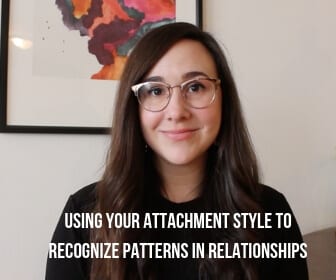Using Your Attachment Style to Recognize Patterns in Relationships [Transcript]
Many different kinds of relationships can be impacted by your attachment style. If you are new to the theory of attachment, you might (very understandably) be wondering “what is attachment?” Attachment refers to the kinds of strategies that we use within our interpersonal relationships in order to maintain a sense of safety. This is based on our earliest relationships in life with our caretakers. Caretakers can be parents, guardians, or whoever cared for you early on.
For example, if your caretaker was available to you, provided appropriate care and soothing when you were distressed, but also let you explore the world around you and be independent, it is very likely that you tend to form secure attachments today. What that means is that you feel confident that you are going to get your needs met in relationships and that you generally feel that it is safe to depend on other people.
Many of us, however, had early life experiences that may have resulted in a not-so-secure attachment style. This includes those of us whose parents were a bit distant or were way too close and didn’t allow exploration and independence. It also includes those whose parents struggled to tolerate outbursts of emotion, or parents who were unpredictable or unsafe in their behavior. These types of relationships can result in an insecure attachment style.
Insecure attachment styles can be broken down into anxious attachment and avoidant attachment. Anxious attachment is characterized by being overly preoccupied with the possibility of being abandoned in relationships. Avoidant attachment is characterized by a need to disengage emotionally, and sometimes physically, to maintain a sense of safety.
Why is all of this important? Since your early life experiences form a blueprint for how to stay safe in relationship to others, it is possible you are still using that blueprint even with situations in which it’s not really useful. You might find yourself avoiding people who you would like to get close to or becoming really worried about whether or not somebody really cares about you.
Romantic Relationships
We often look at attachment styles through the lens of romantic relationships and this makes a lot of sense, because these are usually very close relationships where there is enough safety for conflict to emerge. Attachment styles tend to show up in conflict. That said, there are plenty of other places where your attachment style can show up. Let’s look at how attachment can impact other types of relationships.
Watch: Attachment Styles in Relationships
Close Friendships
Attachment styles can impact close friendships. An example would be when you feel really worried when you text a friend and they don’t text you back. You might find yourself ruminating and wondering if you did something wrong. This would be an example of anxious attachment.
With avoidant attachment, your friends may often tell you that they don’t really know you. You might feel like you are being as open as possible, but there is still something that feels inaccessible to your friends.
Work Relationships
Another place attachment can show up is in the workplace. For example, if you are anxiously attached and receive some negative feedback from your supervisor, you may find that you can’t stop thinking about this feedback. You may check in with other people in your office to make sure you are still a good employee and a good person.
At work, an avoidantly attached person might forget to ask for help on something they really don’t understand. This is because it is not in their nature to seek out others for help.
Relationships with Power Imbalance
Another place where attachment may show up is in any relationship where there is some kind of power imbalance. These can be relationships with teachers, mentors, religious authorities, and even your therapist. These are all relationships that in some ways resemble a parental relationship. It makes sense, then, that they are also relationships where your attachment style can show up.
Adult Relationships with Parents
On the subject of parental relationships, it is important to realize that your attachment style is still in play with your parents, even though you are an adult. It can be distressing to feel pulled back into that dynamic.
So, what’s the good news in all of this? Understanding your attachment style can be instrumental in helping you develop self-compassion. This is especially helpful when you behave in ways that don’t make sense to you. Instead of asking “why did I do that?” you may want to try asking yourself “how is this related to my attachment style?” This may help you to stop beating yourself up.
Another reason why attachment brings good news is because it is flexible. You might be oriented toward one end of the attachment spectrum. Through new relationships, new experiences, and lots of practice, however, it is entirely possible to move towards a secure style of attachment.
If you’d like to know more about attachment styles and how this knowledge can help you understand and manage confusing behaviors, please register for my upcoming webinar “Why Did I Do That? Feel More in Control by Understanding Attachment Styles.”
- The Relationship Between Suppressed Emotions and Depression - August 19, 2021
- Trauma and Relationships: How to Help a Partner with a Trauma History - November 12, 2020
- What is a Trauma Trigger? - April 16, 2020




7 comments
I love that you share these concepts (in this video and the previous) and then crush any seed of shame about it before it can even start. Framing things with self-compassion is so important and we all need constant reminders of that.
Such a clear and accessible overview of attachment styles and relationships. Looking forward to the webinar!
Great video blog, Christy! I really like the way you explain how attachment can show up in different areas of life. Understanding these concepts can really reduce the stress many people feel due to their attachment style. I am looking forward to your webinar.
I love how this video discusses attachment styles in other areas of life, including workplace, and friendships. People often associate attachment only with romantic relationships. But it’s really important to learn and know that our attachment style effects almost all of our interactions.
I love this blog, Christy! You so clearly explain different attachment styles and how they impact different kinds of relationships. I especially find it helpful and hopeful to be reminded that people can shift their attachment styles to become more securely attached through new relationships.
This is an amazing video blog on attachment! For those who know about attachment, there is so much focus on how it affects romantic relationships, but it important to understand where else attachment styles can come into play. You do such a great job of explaining all of this, so I can’t wait to watch your webinar!
Christy, you do such a great job of explaining attachment styles and how they relate to many kinds of relationships, all with a compassionate stance. It is so important to consider how attachment can impact important non-romantic relationships like those with coworkers and close friends. Great video blog–I look forward to your webinar later this month!